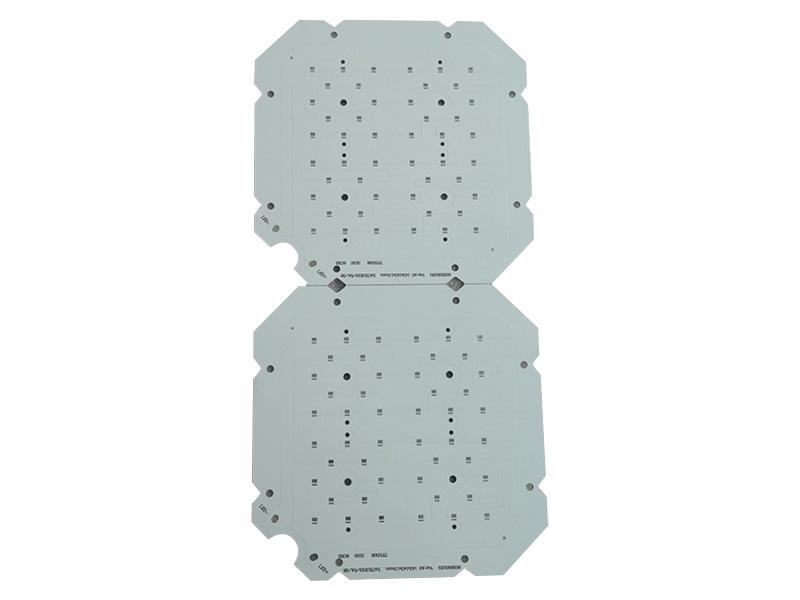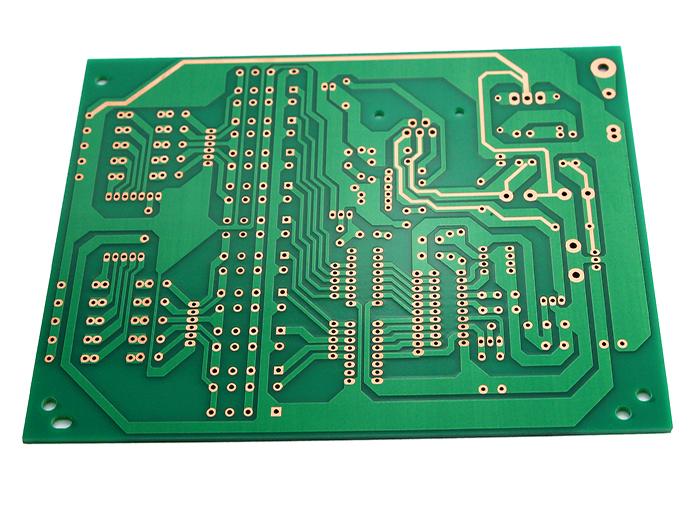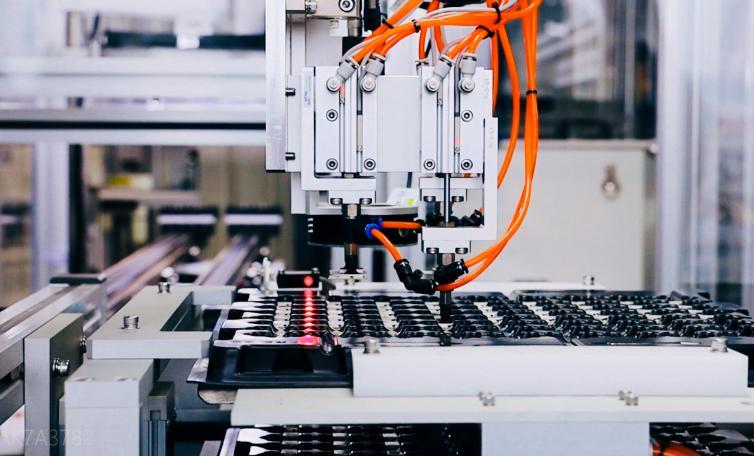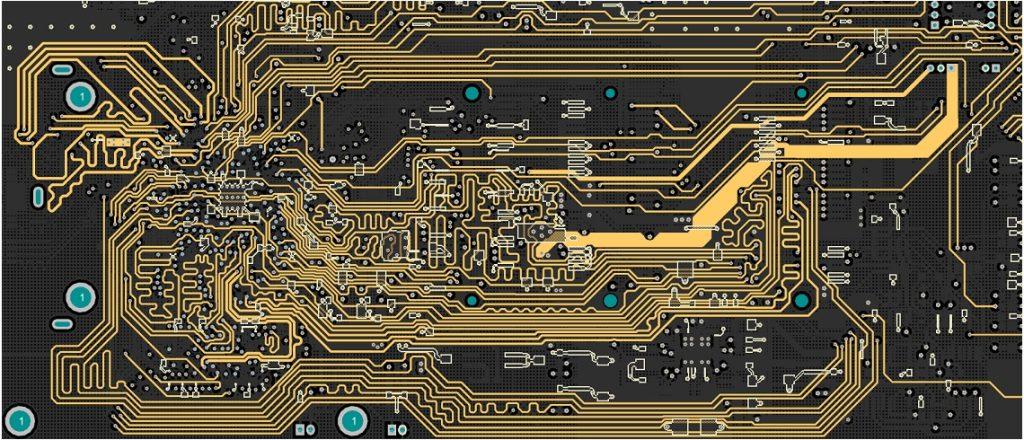- What is an aluminium substrate PCB?
- PCB aluminium substrate has what characteristics?
- Aluminium substrate PCB structure composition
- The aluminium substrate is an effective solution for high power and high heat dissipation PCBs
- Summary
Using aluminium PCBs is a very effective solution when heat dissipation requirements are very high in PCB designs. This design using an aluminium substrate can better transfer the heat from the design components and thus control the temperature of the product. Compared to an equivalent fibreglass backplane, it is typically ten times more efficient at removing heat from circuit components. This significantly higher level of heat dissipation allows for higher power and density designs.
What is an aluminium substrate PCB?
The aluminium substrate is a good heat-dissipation metal laminate; it is the basic material for high-power power electronic circuit structures and interconnection technology. PCB prototype, aluminium substrate general single board includes three layers of structure, respectively, circuit (copper foil), insulation layer and metal base; double-sided panel, structure circuit layer, insulation thermal conductivity layer, aluminium base, insulation thermal conductivity layer, circuit layer. There is another double-sided aluminium substrate made of glass fibre board mixed with an aluminium base; the bottom layer is an aluminium base, the core board is aluminium, and the top and bottom alignment.
PCB aluminium substrate has what characteristics?
1, PCB aluminium substrate surface with mounting technology (SMT); PCB aluminium substrate has good thermal runnability in the circuit design scheme.
2, PCB aluminium substrate can reduce the temperature, improve product power density and reliability, and extend product life.
3, PCB aluminium substrate can reduce the size, hardware, and assembly costs.
4, PCB aluminium substrate can replace ceramic substrate for better mechanical endurance.

Aluminium substrate PCB structure composition
1、Line layer
The line layer (generally using electrolytic copper foil) is etched to form the printed circuit, which is used to achieve the assembly and connection of devices. Compared with the traditional FR-4, the aluminium substrate can carry a higher current using the same thickness and line width.
2、Insulation layer
The insulation layer is the core technology of aluminium substrate, which mainly plays the function of bonding, insulation and thermal conductivity. The aluminium substrate insulation layer is the largest thermal conductivity barrier in the power module structure. The better the thermal conductivity of the insulation layer, the more conducive to the diffusion of heat generated by the operation of the device; it is also conducive to reducing the operating temperature of the device to improve the power load of the module, reduce the volume, extend the life, improve power output and other purposes.
3、Metal base
Insulation metal substrate using what metal needs depends on the coefficient of thermal expansion of the metal substrate, thermal conductivity, strength, hardness, weight, surface state and cost and other conditions of careful consideration.
The aluminium plate is ideal because of its cost, technical performance, and other conditions. The available aluminium sheets are 6061, 5052, 1060, Etc. If there are higher thermal conductivity, mechanical properties, electrical properties and other special performance requirements, copper, stainless steel, iron and silicon steel plates can also be used.
The aluminium substrate is an effective solution for high power and high heat dissipation PCBs
High heat dissipation requirements of printed circuit boards are applying aluminium-based design.
Aluminium-based PCBs are being used in high power/high heat dissipation applications. Examples of LED applications include traffic lights, general lighting and automotive lighting. Using aluminium-backed designs (LED PCBs) allows higher-density LEDs in board designs and allows the installed LEDs to be driven at higher currents while remaining within temperature tolerances. Using an aluminium-backed design allows designers to reduce the safety margin for power LED usage and reduce the usage of said LEDs below that of traditional PCB designs. As with all components, the lower the operating temperature of the LEDs in the design, the longer the LEDs can operate before they fail.
Other applications for aluminium-based PCB designs include high-current circuits, power supplies, motor controllers, and automotive applications. For any design with high-power surface mount ICs, aluminium substrate PCBs are the perfect thermal solution. In addition, they can eliminate the need for forced ventilation and heat dissipation, which ultimately reduces design costs. Any design that can be improved by higher heat transfer and better temperature control can be applied to aluminium-based PCBs.
Conventional PCBs use a glass fibre substrate (FR4 is the standard substrate used by PCB manufacturers), an aluminium substrate PCB, a high thermal conductivity dielectric layer and a standard circuit layer composition. The circuit layer is a thin PCB bonded to the aluminium backing layer. Therefore, the circuit layer can be as complex as a circuit layer mounted on a conventional fibreglass backing.

Aluminium-based PCB improves the thermal conductivity of power components.
While it is more common to see single-sided designs, aluminium-backed designs may also be double-sided, with the circuit layers connected by highly thermally conductive dielectric layers on either side of the aluminium backing. These double-sided designs can then be connected via plated holes. The aluminium backing provides an excellent thermal path to the surrounding environment or any connected heat sink, regardless of the configuration. Once again, improving the thermal conduction of power components is the best way to ensure design reliability, and aluminium-based PCBs offer an excellent solution to this problem.
The solder mask layer of the circuit portion of an aluminium-based PCB can be made in many different colours than traditional PCB designs. In LED designs, the solder mask layer is usually white. White solder masks allow for higher levels of light reflection from the associated LED array and produce a more efficient design. In power designs, solder masks are typically black to radiate heat better.
Aluminium-based PCB provides high mechanical stability.
Aluminium-based PCB designs also offer high mechanical stability for applications that require a high level of mechanical stability or are subjected to high levels of mechanical stress. Furthermore, they are less susceptible to thermal expansion than glass fibre-based structures. If your design does not require a high level of heat transfer, but the board will be subject to a high level of mechanical stress or has very tight dimensional tolerances and will be subject to much heat, then using an aluminium-backed design may be warranted.
Summary
Aluminium is not the only available metal backing material. Copper and copper alloys are also used as backing materials, although they are less popular due to their typically higher cost. Compared to aluminium, copper and copper alloys have higher performance in terms of thermal dissipation. Therefore, if the standard aluminium backing design does not meet the thermal requirements of the design, using copper can be seen as the next step in solving the problem.
Therefore, using aluminium-based PCB board solutions can increase the reliability and lifetime of a design through temperature control and the resulting low component failure rate. In addition to excellent temperature control characteristics, aluminium designs offer high mechanical stability and low levels of thermal expansion. When standard fibreglass (FR-4) PCBs cannot meet your design’s thermal and density requirements, aluminium substrate PCBs may provide the ultimate solution.



